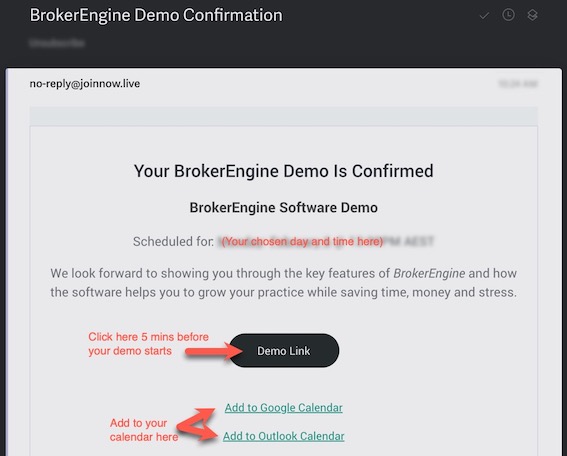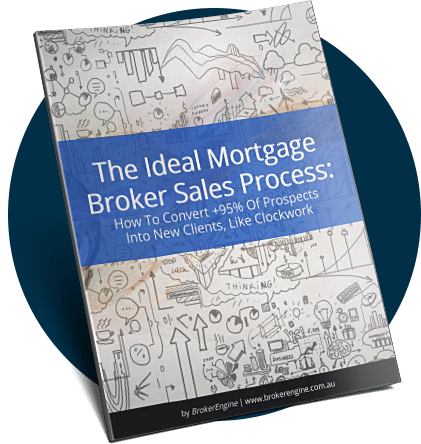Mortgage brokers now originate two-thirds of all Australian home loans. Over the past decade, market share has surged from 45% (2013) to 54% (2018) to over 70% in 2023.
Here are the top team, technology and market trends that are shaping the transformation of mortgage broking in 2024 and beyond. (Scroll down for a full analysis).

I hope you found this infographic useful. Now here’s a longer form version of the Mortgage Broking Industry Trends for 2024:
1. The Rise Of Rockstar Brokers On Social Media
The era of simply doing good work and relying on passive word-of-mouth referrals is behind us.
Today’s top-performing brokers are actively using their brand and content to create personal connections with extensive audiences through social media.
Unlike traditional one-to-one word-of-mouth referrals, which depend on encountering a friend or family member in need of your services — social media operates differently. It uses intelligent algorithms to determine the people most likely to engage with your brand and content, providing the potential for viral reach and rapid audience growth.
2. Shift From “Generalist” To “Specialist”
Until recently, a physical storefront was practically essential for client credibility. This protected local “generalist” brokers who focused on servicing clients in their own backyard.
Lower geographical barriers have made niche service models more practical. Clients are becoming savvier about the advantages of specialised solutions, which poses a challenge for generalist brokers. With more niche operators entering the market, the middle market for generalist brokers has become increasingly competitive.
In response, brokers are embracing differentiation and specialisation to safeguard their client base. This shift is supported by advancements in online communication, digital applications and document collection, and targeted hyper-targeted advertising.
3. AI & ChatGPT Are Here (For Real This Time)
Artificial Intelligence came into its own with the public release of ChatGPT at the end of 2022. Now a massive opportunity exists for early adopters.
- Solid applications for AI are here – these already outpace and outperform smart humans!
- It’s evolving FAST – AI capability is DOUBLING every 2.5 months
- Data privacy and handling of PII is an issue – and solutions are evolving
- Exponential gains on every front – firms that do not adopt will be left in the dust
The buzz around AI in recent years has been considerable. Until now, it has often fallen short of expectations, or its proposed applications seemed so unrealistic that you might have dismissed it entirely. Our advice? Do not remain on the sidelines any longer. The upcoming developments in AI are poised to be swift and substantial. Brokers who ignore these advancements risk being left behind.
4. Innovative Team Structures Are The New Normal
COVID may be behind us, but its transformative effect on team structures remains. While the basics of writing a loan are unchanged, how it gets done varies widely from one practice to another.
- Onshore vs. Offshore: The shift to remote work during COVID-19 helped challenge long-standing beliefs about office-based tasks. Brokers who may have previously dismissed the benefits of offshoring are now reconsidering, especially given the challenges in finding local talent and the increased pressure on profit margins.
- Division of Labour: Digital workflows, offshore teams, AI, and evolving local job roles allow for a task to be divided in numerous ways. This flexibility means that each practice can tailor their approach to suit their needs and resources.
- Team Structures: The concept of a “typical mortgage broker practice” no longer exists. The most effective practice is one that is customised to make the best use of the best team structure and resources available to you.
- Gig Workforce: The gig workforce offers the ability to scale teams according to demand. This approach, however, comes with its own set of challenges, such as employee retention, safeguarding intellectual property (IP), maintaining team culture, and effective management.
- Technology & AI: The role of technology and AI in reshaping practices is profound, going beyond minor efficiencies or workflow adjustments. It’s a complete overhaul of the roles and personnel requirements in a practice, creating new opportunities and making some traditional roles obsolete.
- Flexible Work: While flexible working arrangements boost retention and employee satisfaction, they also bring considerations for reward structures, culture, management, and IP.
5. Growing Disparity Between Tech-Enabled And Not
Technology transitioned from a “nice to have” to an indispensable component in nearly every aspect of mortgage broking. In the past, tech played a back-end role. While tech-enabled brokers enjoyed operational efficiencies, the overall customer experience remained relatively unaffected. This meant that practices that weren’t as advanced could still throw people at the problem.
Nowadays, clients expect a high-quality digital experience. This shift has made it glaringly obvious when a broker’s digital capabilities are lacking. Aspects like digital scheduling, communication, document collection, and application processes are no longer unique competitive advantages but basic customer expectations. (See our full list of Top Mortgage Broker Tools.)
However, there’s resistance against the proliferation and expense of the necessary tech tools. Brokers should evaluate each new app and ensure it will add value rather blindly adding yet another shiny object.
Brokers nearing retirement may be inclined to avoid these new technologies, preferring to stick with familiar methods. But this reluctance can adversely affect their immediate business performance and potentially diminish the future value and attractiveness if they choose to sell their practice.
6. Clients Expect A High-Quality Digital Experience
The digital “honeymoon period” is over. Clients now expect fast, convenient and secure digital experiences across the entire lending lifecycle:
- Cyber Awareness and Data Security: Clients are highly sensitive to mortgage broker cyber security and data practices. Practices found to be careless with client data face intense scrutiny and backlash, underlining the necessity for lenders to maintain stringent security measures to protect personal and financial information.
- Secure Portals and Easy Access: Clients expect seamless, secure online platforms that allow easy access to loan information. Intuitive and straightforward navigation is key for these digital portals.
- Remote Interactions: Clients are now comfortable with conducting consultations and meetings remotely, valuing the convenience and flexibility it offers.
- Need for E-signing: Given that most clients no longer own printers or fax machines, e-signing has become critical. Friction in the document signing process can lead to delays and a cumbersome experience, which is bad news for everyone!
7. Ongoing Channel Conflict, Especially Around Pricing
Mortgage brokers and banks are caught in a frustrating struggle between client interests and bank pricing/retention practices.
Mortgage Brokers:
- Knowledge of the Market: They have a comprehensive understanding the lender and product landscape.
- Client-Centric Approach: Brokers are legally obligated to act in a their clients’ best interests. They are well-versed in the strategies and incentives banks use to attract new borrowers. Brokers also recognise that less proactive, passive borrowers often end up with less advantageous deals.
- Engaging Current Lenders: Typically, brokers first approach the client’s current lender for better terms before advising a change, balancing professional courtesy with client benefit.
Lenders/Banks:
- Attracting New Borrowers: Lenders often offer lower rates to new borrowers, encouraging them to switch from their current providers.
- Reactive to Threats of Switching: Existing borrowers usually receive better offers only when they indicate a willingness to switch lenders, leading to potential refinancing frustrations.
8. The Market Is Set To Shift (Again)
With interest rates swinging from record lows to 11-year highs in just 18 months, brokers must stay agile to manage the implications for borrowing and repayment strategies.
- Fluctuation Between Acquisition and Retention: Brokers need to adapt their strategies to balance acquisition and retention in times of less certain economic outlook.
- Constantly Evolving Lending Strategies and Loan Types: As market conditions change, so do lending strategies and loan offerings. Brokers need to ensure they’re providing current advice.
- Shifting Borrower Sentiment and Urgency: Borrowers’ urgency or hesitancy is influenced by rate changes and economic outlooks. Brokers need to ensure they’re responding appropriately.
- Loan Products and Rates Changing Regularly: With loan products and rates regularly adjusting, brokers must stay informed to guide their clients effectively.
Given the potential for rate changes in 2024, brokers are reminded that change is constant, and staying informed and adaptable is crucial.
9. Broker Share Continues To Increase
More Australians are using brokers than ever before, with brokers now writing more than 2 out of every 3 home loans.
- Focus on Unique Practice Benefits: Clients broadly understand why they should use a broker. Rather than trying to ‘sell’ them on the general benefits, it’s crucial to promote your unique advantages and points of differentiation.
- Boost in Innovation and Investment: The growing market share of mortgage brokers spurs innovation and investment in the sector, leading to a larger and more competitive marketplace of apps, tools and providers.
- Room for Growth: Compared with the UK, where brokers write about 75% of home loans, the Australian market still has potential for growth.
10. Looming Digital Disruption
Technology is drastically changing how we handle data, security, and finance, with both subtle and significant industry impacts.
- Online Platforms & Comparison Sites: Online platforms and comparison sites are becoming more efficient, offering easier and more comprehensive financial product comparisons. (Could these disrupt mortgages in the same way they did the travel industry?)
- AI-Driven Approvals: Artificial Intelligence (AI) and machine learning are streamlining loan approvals, enabling faster, automated, and more accurate processes.
- Blockchain for Secure Transactions: Blockchain technology is being employed for more secure and transparent financial transactions.
- Enhanced CRMs: Smarter CRMs are improving client experiences through automation and better data management.
- Big Data in Lending: Big data and analytics are being used to create more personalised loan products and lending solutions.
In this context, considering Jeff Bezos’ question, “What’s NOT going to change?” becomes crucial for long-term strategic planning in the finance sector.
Conclusion and Next Steps
The mortgage broking industry trends covered above are not a mystery – they are already upon us and accelerating every day.
The question is, how well are you positioned to take advantage of them? And what decisions do you need to make today in order to ensure your firm is able to ride on the crest of the wave?
If you’re interested in finding out how BrokerEngine software can help you apply Specialisation, Division of Labour and Process Excellence to deliver a 5-star customer experience at scale and settle more deals in less time, please register for our latest demo here.






